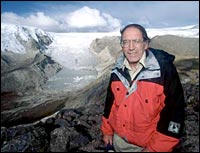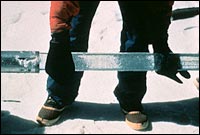Lonnie Thompson has clocked more hours above 18,000 feet than any other person in history, and yet he doesn’t exactly like climbing mountains. A masochist? No, just a hard-driving climate scientist.

The iceman cometh.
Photo: Courtesy Lonnie Thompson.
Thompson treks up the highest peaks of the tropics — including the Himalayas and Andes — to extract ice-core samples. He then takes the samples back to giant refrigerated vaults at Ohio State University’s Byrd Polar Research Center, where he analyzes the air and debris captured in the ice to get a picture of historic temperatures, greenhouse-gas levels, and weather events stretching back as many as 750,000 years.
“I think it’s safe to say that worldwide, the warming trends of today are more dramatic than they have been in at least 5,000 years,” Thompson says. He’s particularly worried about this because his glacial stomping grounds are shrinking so fast they could vanish completely by mid-century, taking with them an invaluable geological archive.
Thompson’s decades of research and extreme expeditions have been chronicled in a new book by Mark Bowen, Thin Ice: Unlocking the Secrets of Climate in the World’s Highest Mountains. Thompson spoke to Grist from his Ohio office in early January, as he was gearing up for a trip to Mount Kilimanjaro in Tanzania.
Let’s start with a quick snapshot of the expedition you’re embarking on.
The major objective for the trip to Kilimanjaro is to have new aerial photographs made of the mountain and make a map of how much ice has been lost since 2000, when we last assessed it. We can determine not only the loss of area of ice on the mountain, but also the volume of ice lost as well. We determined the ice thickness when we were drilling there in 2000, and put in stakes so we could come back and measure the glacial accumulation or the ablation — loss of ice — on subsequent trips.
Do you expect to find loss of ice?
We actually know from people who have measured our stakes that we have already lost two to three meters of ice from the surface since 2000.
To me, it’s very telling that nothing is accumulating in today’s world. If you look at the tropical region in general — from the Andes to the Himalayas — many of those glaciers will disappear within 50 years if current rates of mass loss continue. Unfortunately, people in surrounding villages depend on these ice fields for water resources.
You work exclusively in tropical regions — the South American Andes, Africa’s Kilimanjaro, Asia’s Himalayas. Why these climes rather than the polar regions?

Perusing the glaciers of Peru.
Photo: Thomas Nash.
The tropics encompass 50 percent of the surface area of the planet and are home to 70 percent of the world’s 6.4 billion people, so they reveal data that are specific to populated regions. More important, tropical heat is an important driver of climate change as it fuels big storms, hurricanes, and weather patterns that have implications worldwide. If a small increase in carbon dioxide boosts tropical temperatures even just a smidge, the tropical oceans will release more moisture, which in turn will increase temperatures worldwide via the enhanced greenhouse effect as water vapor is the most important greenhouse gas.
There’s another key difference: The polar regions are largely covered by huge ice masses that act like a giant mirror, reflecting heat rather than absorbing it. In other words, the region keeps itself cold, controlling weather patterns rather than responding to them. These smaller ice caps and mountain ice fields in the tropics can’t do that. They are going to respond to the fluctuations in mean temperatures around them that are driven by changes in vegetation, land use, ocean temperature and circulation — forcings that are so much bigger than they are. In that sense, they give a more faithful reading of climate trends.
Can you give a snapshot of a typical day on an expedition?
Your typical day drilling at 23,500 feet generally begins with being snowed into your tent — when you wake up, you can’t get out because the overnight snowfall is covering the entrance. So you must dig yourself out. In front of the tent is a kitchen and dining area that we carve out of the snow with a platform of snow in the center as a table and benches around the edges. After breakfast we go to this geodesic dome where a solar-powered drill has been erected and extract samples until sundown.
How many expeditions do you have under your belt?
An expedition to me is spending more than one month and having a team greater than six people. This project will be my 50th. We also make shorter ascents with smaller teams to scout out sites. If you count those, it would be over a hundred.
What would you say is the single most important of these?
I always think it’s the next one.
What are some of the health risks of working at extreme altitudes?
I have now taken 880 people over 18,000 feet and I can say that most people can adapt to these higher elevation environments. That said, we have had team members who experienced blood clots, temporary loss of eyesight, pulmonary edema — in which the lungs fill with fluid, and strange stuff that’s not written up in the medical books. The reality is that you can reduce the risk but you can’t eliminate the risk that comes with traveling to and working at high elevations. You could go up 30 times without a problem, and on the 31st time you could have a problem.
There are also risks associated with glacial melt. A group of mountaineers was recently crushed by falling boulders on Kilimanjaro because warming temperatures are melting the ice on the mountain.
If I could get the necessary data by another, safer approach, I would. But none of these sites are accessible by aircraft or vehicle. As it is, we always look for the easiest route with the least risk possible to get to the drill site. The main reason I venture to these places is that I believe the scientific and social importance of the data outweigh the risks. But there is an upside to the survival challenge: Sometimes you don’t come to know what you’re really made of until you’ve been forced against the wall.
Would you characterize yourself as a thrill-seeker?
My first time to Antarctica was back in ’73 and there was a climber on our team who convinced me that on our way back to the U.S. we should ascend a peak near Mount Cook. I had never climbed a mountain. We got up at 3 a.m. and climbed all day. I remember being up on top — it’s just a narrow rim. On the descent, we were belaying each other and started slipping. We were going over this cliff where it was 2,000 feet below before you would hit anything. I thought, if I get off of here still alive, I will never climb another mountain for the fun of it. And I never have.
What drew you to glaciology?
I intended to get my graduate degree in coal geology, of all things. I’d grown up in Gassaway, W.Va., and the only major employer in the area was a coal mine. I stumbled into glaciology as a research assistant at Ohio State. I got to analyze some of the first ice-core samples ever taken, and was amazed to find they told such an intricate story of weather and atmosphere.
Meteorology has been a passion since I was a kid. I was known as “The Weatherman,” because I jury-rigged a weather station in the garage and sold daily forecasts for lunch money. I got paid only if I got it right, and managed to beat out the radio forecasters.
What can we learn from glaciers that we can’t get from other indicators of climate history, such as tree rings and coral reefs?

An ice core’s worth a thousand words.
Photo: Lonnie Thompson.
What I really like about glaciers is that they are not living. A biological system can adapt, it can change, whereas glaciers are simply a physical system. Therefore if you can understand the physics of that system, you can understand the climate record it holds without making inferences about adaptation.
The other part of it is that the ice records whatever falls within the snow. It can be emissions from a volcanic eruption, or evidence of changes in the monsoon, El Niño, solar output, atmospheric pollutants, pollen. It can be anything. You’re not only recording the climate and environmental response but also the forcings that drive the climate system. There is no other archive that records so many different parameters.
How do you date and analyze the ice cores?
Several methods: The most primitive and also the most accurate is to actually measure the layers of dust that accumulate on the ice surface every year, a method akin to counting tree rings. The chemical composition of the gas in the bubbles that are in the ice can also be measured. And we use carbon-dating methods to analyze the organic materials like insects and plant remains trapped within the ice.
What do you plan to do, ultimately, with the data you’ve collected?
My dream is ultimately to piece together a global map of past climate patterns. Right now we have piecemeal evidence reflecting different regional patterns — we know that some areas are the warmest they’ve been in 40,000 years, while some are the warmest they’ve been in 6,000 years. I think it’s safe to say that worldwide, the warming trends of today are more dramatic than they have been in at least 5,000 years — but we must have a more comprehensive map to see how all these trends fit together.
How many pieces of the puzzle are left to procure before you can spend your time doing pure analysis?
There are sites throughout the world that we have identified as important, but have not drilled yet — important because they are high enough that melting is not compromising the record, and thick enough that you can get a long-term time perspective from that archive. They would not take long to drill and recover if you had the resources and could focus on them quickly. Of course, one of the problems we face now is that the lower-elevation sites are starting to disappear.
In the past, Congress has put pressure on the National Science Foundation to cut funding for climate research due to the politicization of the climate debate. Has that pressure subsided?
I think it has not subsided at all. I feel that recently it’s been worse. I find this situation unbelievable. Clearly, if we are to have the best information available, then we must have a free, objective scientific community that is allowed to do their research, interpret the record as best they can, and then publish their result without fearing that there might be consequences, either personally or for the funding agency.
Ultimately, are you optimistic that humans will prevail over climate change?
Your mind-set has to be: Just because it hasn’t been done before does not mean that it can’t be done. I’m coming from a perspective where, for decades, we have managed to take an international team and accomplish something that many people have said is impossible. That gives me hope for the future. Once we as human beings realize that we have a real obstacle to overcome with respect to the future of climate change and resource depletion, I believe we will work together and make it happen.

